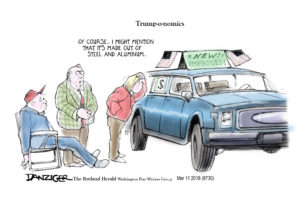We Finally Know When Humans Started Changing the Climate
Researchers can now pinpoint when our influence on the earth’s environment began. Tree rings tell a complex thousand-year story. (Garry Knight / Wikimedia Commons)
Tree rings tell a complex thousand-year story. (Garry Knight / Wikimedia Commons)
Our influence on the Earth’s environment has lasted for a century: the human impact on droughts and moisture patterns began at least 100 years ago, researchers now say.
US scientists used new analytic techniques and almost a thousand years of tree-ring data to build up a picture of drought and rainfall worldwide for the last century. And they report in the journal Nature that they have identified the human fingerprint upon climate variation as far back as the first days of the motor car and the infant aircraft industry.
The pattern of change, in which regions prone to drought such as the western US became more arid, grew visible between 1900 and 1949. The researchers saw the same pattern of drying in those decades in Australia, Europe, the Mediterranean, western Russia and southeast Asia.
At the same time more rain and snow fell in western China, much of central Asia, the Indian subcontinent, Indonesia and central Canada.
Clear signal apparent
Kate Marvel of the Nasa Goddard Institute for Space Studies, who led the research, said: “It’s mind-boggling. There really is a clear signal of the effects of greenhouse gases on the hydroclimate.”
And Benjamin Cook of both the Nasa Institute and the Lamont-Doherty Earth Observatory at Columbia University, said: “We asked, does the real world look like what the models tell us to expect? The answer is yes.
“The big thing we learned is that climate change started affecting global patterns of drought in the early 20th century. We expect this pattern to keep emerging as climate change continues.”
For four decades it has been a given of climate change research that average planetary warming will intensify all the extremes of weather: in particular, drought and flood.
“All the models are projecting that you should see unprecedented drying soon, in a lot of places”
The problem has been that droughts and floods have always happened. But could scientists identify the signature of human change – the clearing of the forests, the intensification of agriculture, the growth of the cities and the ever-increasing use of fossil fuels to dump ever more carbon dioxide in the atmosphere – in any one flood or drought? Until this century, researchers were unwilling to name the guilty party.
No longer. In recent years researchers have done more than just blame overall warming on human activity, and in particular the increasing hazard of extremes of heat, drought and flood.
They have linked human behaviour with drought in California and with record temperatures in 2013 in Australia.
The Nasa-led research is not quite the first to claim to have detected very early evidence of climate change. A team led by Chinese scientists reported in April in the journal Nature Sustainability that tree ring evidence from the Tibetan plateau suggested that humans may have begun altering the pattern of seasonal temperatures – that is, the differences between winter and summer – as early as the 1870s, at least in the northern hemisphere.
Puzzle solved?
But the latest study from Dr Marvel and colleagues identifies such evidence on a wider scale, and may even have resolved the puzzle of the extremes that did not happen.
The research found three distinct periods of change. The first was marked by more drought in some places, more precipitation in others in the first half of the 20th century. But by the height of the Cold War, and the space race mid-century, it became harder to see a pattern, and climate events seemed more random, and climates cooler.
The researchers now think the huge volumes of aerosols from power stations, factory chimneys and vehicle exhausts between 1950 and 1975 altered weather patterns in different ways, affecting cloud formation, rainfall and temperature, to mask the effect of greenhouse gas increases.
These were the years of choking smog, grime and soot, sulphurous droplets, acid rain, corroding historic buildings and urban respiratory disease on an epidemic scale.
Stronger pattern expected
And then developed nations started introducing clean air legislation and other pollution controls. Round about 1981, tentative evidence of the impact of human-driven greenhouse gas emissions began to show again in the climate record, although not as boldly as in the first half of the century.
If the researchers have got it right, the pattern of increasing drought, matched elsewhere by increasing precipitation, will continue to become stronger.
“If we don’t see it coming in stronger in, say, the next 10 years, we might have to wonder whether we are right,” Dr Marvel said. “But all the models are projecting that you should see unprecedented drying soon, in a lot of places.”
And the researchers warn that the consequences for humankind, especially in North America and Eurasia, could be severe.
Your support matters…Independent journalism is under threat and overshadowed by heavily funded mainstream media.
You can help level the playing field. Become a member.
Your tax-deductible contribution keeps us digging beneath the headlines to give you thought-provoking, investigative reporting and analysis that unearths what's really happening- without compromise.
Give today to support our courageous, independent journalists.




You need to be a supporter to comment.
There are currently no responses to this article.
Be the first to respond.